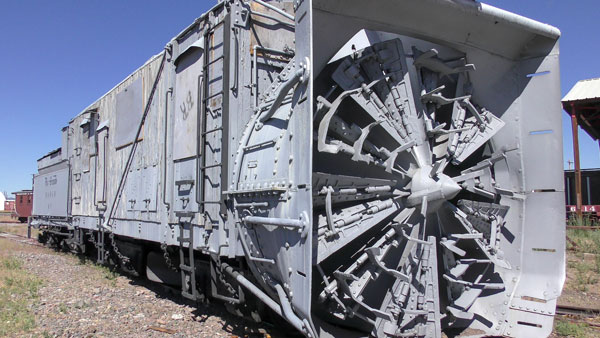ANTONITO, Colo. — Cumbres & Toltec Scenic Railroad moved its rotary snowplow OY in preparation for its 50th anniversary of the operations in 2020. In June, the railroad moved it from Chama, N.M., to Antonito, Colo., for rehabilitation. The goal is for OY to once again clear snow on the 64-mile track between Chama and Antonito, a duty which it has not performed since 1997. The rotary plow is poised to operate as part of a photo excursion train on Feb. 29 and March 1, 2020. The excursion is sold out, with more than 500 people on the waiting list.
American Locomotive Co. built rotary plow OY in 1923 and delivered it to the Denver & Rio Grande Western Railroad. The tender was from an old D&RGW steam locomotive. OY was stationed in Alamosa for use on the eastern portion of the Cumbres Pass while her sister plow, OM, was stationed in Chama.
“If this thing has 90 days of service on it since it was built in 1923, I’d be very surprised,” says Stathi Pappas, director of special projects for the C&TS. “We are very fortunate because there really isn’t a whole lot of work that really needs to be done to make it operable, just a lot of cosmetic work, and of course, doing the boiler inspection. Since this is a piece of work equipment, we have spoken with the Federal Railroad Administration about what they feel comfortable with. Even though we don’t have to completely strip this boiler down, we’ve still done our due diligence to make sure that it is safe and suitable for service. Amazingly, this pressure vessel is at blueprint spec for thickness. With so few days of service and having been stored dry all the time, it is in incredibly good shape.”
Temporary plywood covers the window and door openings, while workers build new windows and doors. The existing roof has failed, contributing to carbody deterioration, so a new soldered seam roof will be installed, providing about a hundred years of protection.
Even though the rotary plow is basically a locomotive in a boxcar, it isn’t self-propelled. At least one steam locomotive has to push the plow. Steam generated in the boiler operates front-facing cylinders that drive a jackshaft. The jackshaft has a big bull gear that turns the rotary shaft. The engineer sits on the engineer’s side of the boiler, just like in a steam locomotive, while a fireman feeds the boiler. One or two people in the wheelhouse communicate with the engineer and the pusher locomotive via whistle signals. There’s also an electric telegraph with an annunciator back to the engineer and fireman.
“You had tool racks built into this because when you are going out fighting snow on the pass, it might be a day’s job, it may be a week’s job, or it may be a two-week job,” Pappas says. “It’s more like being on a ship at sea than it is being on a railroad heading for a terminal. You didn’t know how far you were going to get, and you needed to be ready for just about everything. It came with its own cook car, it came with its own sleeping accommodations, it came with its own auxiliary water cars, and it came with its own drop-bottom gondolas that had coal. The rotary train was meant to go out and do battle as long as it took to get the job done.”















Since the “Act to Regulate Interstate Commerce” was developed by Congress in 1889, the limits of Federal jurisdiction per the Commerce Clause of the U.S. Constitution were fully reviewed and defined. This Act caused the creation of the Interstate Commerce Commission (ICC) to review the compliance to the new law. The ICC can only review and police the inTERstate movements of commerce, as any other functions of a railroad came under State jurisdiction or under company management only.
The operation of any railroad machinery, work equipment, work trains are not an interstate movement of commerce and the ICC (now FRA) has no jurisdiction. The ICC never looked at the boilers of Steam rotary snow plows, steam construction cranes, steam construction boiler, steam pile drivers, steam wrecking cranes, steam snow melters, steam weed destroyers or other work equipment operated by steam. These work equipment steam boiler on common-carrier railroad never came under state boiler inspection laws as they moved at various times from state to state and were only under company management which in almost all cases used Hartford Steam Boiler Insurance Company. Some states did not even have boiler inspections departments, such as NM, or VT. Some railroads worked in dozen or more states with this equipment so can you imagine the paper problem with that situation so it did not happen.
The later creation of the Steam Locomotive boiler inspection law only applied to locomotives.
This is an improper procedure:”Since this is a piece of work equipment, we have spoken with the Federal Railroad Administration about what they feel comfortable with.” The legal FRA reply to this would be: “we have no comment-it is out of our jurisdiction-we are Federal”. To reply any other way would make them directly or indirectly liable. The Federal Government is not a contractor or boiler inspection insurance company.